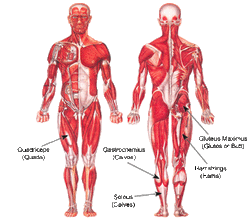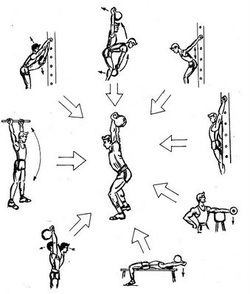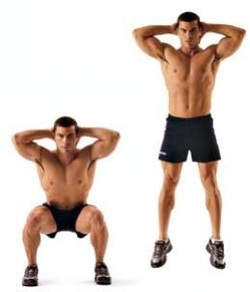Learn How To Jump Higher

For many basketball players or other athletes, learning how to jump higher to improve your sports performance is a struggle for many of them. However, with the right training, you can learn how to develop skills while improving your sports performance at the same time. The only question is, do you know what you can do to achieve this? No worries, if you can learn how to increase your vertical, and be more skilled in your sport, then there is nothing to worry about because this is a benefit that you have discovered and you should apply it so that you can hone your skills and thus, become a better athlete.
If you learn how to do certain excise that will benefit you and give you better sports performance, then utilize these exercises and incorporate them into your own personal workout. Once you figure out. How the body works, then you can achieve success and others will look up to you because you have improved your skills and everyone wants to be like you. What you want to do to increase your vertical, is become explosive.
If you learn how to do certain excise that will benefit you and give you better sports performance, then utilize these exercises and incorporate them into your own personal workout. Once you figure out. How the body works, then you can achieve success and others will look up to you because you have improved your skills and everyone wants to be like you. What you want to do to increase your vertical, is become explosive.
The Main Muscles For Jumping

It should come up in a surprise that if you want to jump higher or how to do it, then you must learn the types of muscles in the legs. Of course you already know, that working the legs will make them stronger and become bigger in size. But you also need to research what muscles are used that will contribute to how high a person is able to jump. You must understand the muscles, and what each muscle is used for, and what specific purpose they all play together. Now we will talk about them.
The quads, the quads are located in front of your hamstrings, or if you still do not know where they are, then put your hands on your lap, those are the quads. The quads contribute to jumping higher because they are the biggest leg muscles. You can do exercises to work out the quads like leg extensions.
The hamstrings, the hamstrings are located just behind the quads, so they are in the backside of your legs. The hamstrings is what generates a force and also the hamstrings is where the most energy travels through when kinetic linking occurs. You could work out the hamstrings as well.
The calves, I think everybody knows whether calf muscles are. But in case you do not, they are right under the knee on the backside. If you are able to flex your calves, then it looks like a small ball behind the knees. The calves greatly contribute to how high a person is able to jump. You can do exercises, like the calf raises and you can do them with your own body weight, or using a weight machine. If you have access to a gym then do weight machines for calves.
The quads, the quads are located in front of your hamstrings, or if you still do not know where they are, then put your hands on your lap, those are the quads. The quads contribute to jumping higher because they are the biggest leg muscles. You can do exercises to work out the quads like leg extensions.
The hamstrings, the hamstrings are located just behind the quads, so they are in the backside of your legs. The hamstrings is what generates a force and also the hamstrings is where the most energy travels through when kinetic linking occurs. You could work out the hamstrings as well.
The calves, I think everybody knows whether calf muscles are. But in case you do not, they are right under the knee on the backside. If you are able to flex your calves, then it looks like a small ball behind the knees. The calves greatly contribute to how high a person is able to jump. You can do exercises, like the calf raises and you can do them with your own body weight, or using a weight machine. If you have access to a gym then do weight machines for calves.
Being Flexible Helps

Another way that you can increase your vertical is by being more flexible. If you're more flexible, then you have more mobility in the legs or whatever area you are flexible. Flexibility is an important issue for the body and especially for training purposes. If you can stretch your hamstrings, your quads, then this helps. If your muscles on the lower body of the leg are not fully stretched out then, you will have a great chance of having an injury occurring. You should also know that, if you are flexible and if you stretch every time you work out, then you are also reducing the chances of you becoming injured. So this is another benefit that you will become acquainted if you stretch and become flexible .
The hip flexors which are basically the beginning of the thighs, is the most important part that you want to be flexible in. If you can be more flexible with your hip flexors then you already will see results in your vertical jump training.
The hip flexors which are basically the beginning of the thighs, is the most important part that you want to be flexible in. If you can be more flexible with your hip flexors then you already will see results in your vertical jump training.
Plyometrics Are The Key

Have you ever heard of what plyometrics are? If you have not, then you will learn what they are now. Plyometrics is another form of training that focuses specifically on explosive muscles. Everybody trains using plyometrics, from high school athletes to even professional athletes. They are widely used around the world and they are used especially for basketball players.
But you should be careful because doing too much plyometrics can be damaging for the joints of the knees, the legs and ankles. If you're going to do plyometrics, then make sure that you start off slow. This is one of the best things that you can do to increase your vertical.
But you should be careful because doing too much plyometrics can be damaging for the joints of the knees, the legs and ankles. If you're going to do plyometrics, then make sure that you start off slow. This is one of the best things that you can do to increase your vertical.
